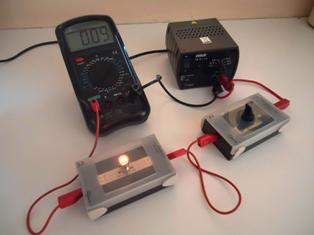Direct current — general concepts, definition, measurement unit, designation, parameters
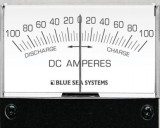 DC — electric current that does not change in time and direction. Per current direction take the direction of motion of positively charged particles. In the event that the current is formed by the movement of negatively charged particles, its direction is considered to be opposite to the direction of movement of the particles.
DC — electric current that does not change in time and direction. Per current direction take the direction of motion of positively charged particles. In the event that the current is formed by the movement of negatively charged particles, its direction is considered to be opposite to the direction of movement of the particles.
Strictly speaking, "direct electric current" should be understood as "constant electric current", in accordance with the mathematical concept of "constant value". But in electrical engineering, this term has been introduced in the sense of "an electric current constant in direction and nearly constant in magnitude."
By "practically constant in magnitude electric current" is meant a current whose changes with the passage of time are so insignificant in magnitude that when considering the phenomena in the electric circuit through which such an electric current passes, these changes can be completely neglected and therefore, it is possible to ignore neither the inductance nor the capacitance of the circuit.
Most often sources of direct current — galvanic cells, batteries, DC generators and rectifiers.
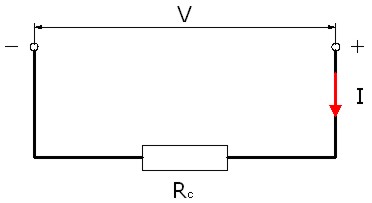
In electrical engineering, contact phenomena, chemical processes (primary cells and batteries), electromagnetic guidance (electric machine generators) are used to obtain direct current. AC or voltage rectification is also widely used.
From all sources of e. etc. c. chemical and thermoelectric sources, as well as so-called unipolar machines, are ideal sources of direct current. The remaining devices give a pulsating current, which with the help of special devices is smoothed to a greater or lesser extent, only approaching the ideal direct current.
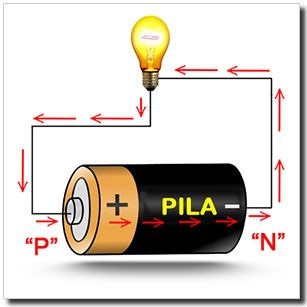
To quantify the current in the electrical circuit is used amperage concept.
Amperage Is the amount of electricity Q flowing through the cross section of the wire per unit time.
If during the time I the amount of electricity Q has moved through the cross section of the wire, then the current strength I = Q /T
The unit of measurement for current is the ampere (A).
Current density This is the current ratio I to the cross-sectional area F of the conductor — I / F. (12)
The unit of measurement of current density is the ampere per square millimeter (A / mm)2).
In a closed electrical circuit, direct current occurs under the action of a source of electrical energy that creates and maintains a potential difference across its terminals, measured in volts (V).
The relationship between the potential difference (voltage) at the terminals of the electrical circuit, the resistance and the current in the circuit is expressed Ohm's law... According to this law, for a section of a homogeneous circuit, the strength of the current is directly proportional to the value of the applied voltage and inversely proportional to the resistance I = U /R,
where I — amperage. A, U — voltage at the terminals of the circuit B, R — resistance, ohms
This is the most important law of electrical engineering. For more details see here: Ohm's law for a section of a circuit
The work done by the electric current per unit of time (second) is called power and is denoted by the letter P. This value characterizes the intensity of the work done by the current.
Power P = W / t = UI
Power supply unit - watts (W).
The expression for the strength of an electric current can be transformed by replacing, based on Ohm's law, the voltage U product IR. As a result, we get three expressions for the strength of the electric current P = UI = I2R = U2/ R
Of great practical importance is the fact that the same power of electric current can be obtained at low voltage and high amperage, or at high voltage and low amperage. This principle is used in the transmission of electrical energy over distances.
The current flowing through the wire generates heat and heats it. The amount of heat Q released in the conductor is determined by the formula Q = Az2Rt.
This dependence is called the Joule-Lenz Law.
See also: Basic laws of electrical engineering
Based on Ohm's and Joule-Lenz's laws, you can analyze a dangerous phenomenon that often occurs when wires are directly connected to each other, supplying electric current to the load (electric receiver). This phenomenon is called short circuit, as the current begins to flow in a shorter way, bypassing the load. This mode is emergency.
The figure shows a scheme for connecting an EL incandescent lamp to the mains. If the resistance of the lamp R is 500 ohms, and the mains voltage is U = 220 V, the current in the lamp circuit will be A = 220/500 = 0.44 A.
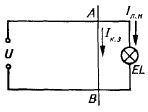
Diagram explaining the occurrence of a short circuit
Consider the case where the wires to the incandescent lamp are connected through a very low resistance (Rst — 0.01 Ohm), for example, a thick metal rod. In this case, the circuit current approaching point A will branch in two directions: most of it will follow a path of low resistance — along a metal rod, and a small part of the current Azln — along a path of high resistance — to an incandescent lamp.
Determine the current flowing through the metal rod: I = 220 / 0.01 = 22,000 A.
In the event of a short circuit (short circuit), the mains voltage will be less than 220 V, because a large current in the circuit will cause a large voltage loss, and the current flowing through the metal rod will be slightly smaller, but however, it will exceed the previously consumed incandescent lamp.
As you know, in accordance with the Joule-Lenz law, the current passing through the wires gives off heat, and the wires heat up. In our example, the cross-sectional area of the wires is designed for a small current of 0.44 A.
When the wires are connected in a shorter way, bypassing the load, a very large current will flow through the circuit - 22000 A. Such a current will lead to the release of a large amount of heat, which will lead to charring and ignition of insulation, melting the wire material, damage to electrical meters, melting through the contact of switches, knife breaker, etc.
The source of electrical energy supplying such a circuit may be damaged. Overheating of wires can cause fire. As a result, during the installation and operation of electrical installations, in order to prevent the irreparable consequences of a short circuit, the following conditions must be observed: the insulation of the wires must correspond to the mains voltage and operating conditions.
The cross-sectional area of the wires must be such that their heating under normal load does not reach a dangerous value. Connection points and wire branches must be of good quality and well insulated. Internal wires must be laid in such a way that they are protected from mechanical and chemical damage and from moisture.
To avoid a sudden, dangerous increase in current in an electrical circuit during a short circuit, it is protected by fuses or circuit breakers.
A significant disadvantage of direct current is that its voltage is difficult to increase. This makes it difficult to transmit constant electrical energy over long distances.
See also: What is alternating current and how does it differ from direct current

